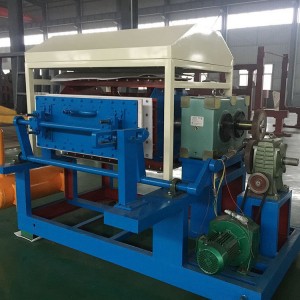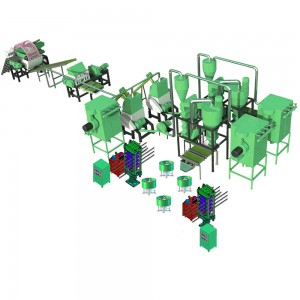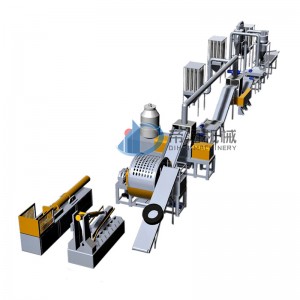Paper Tray Production Line
Paper tray production line also called egg tray making machine, it can be widely used as inner packaging for various commodities such as poultry and eggs, fruits, bottled beverages, glass and ceramic products, handicrafts, small machinery, components, electronics, electrical products, toys, etc., gradually replacing EPS foam plastics and corrugated paper liners.
Paper tray making plant working process
Paper tray making plant also have great potential in medical, agricultural, and horticultural fields, such as successfully developed disposable medical supplies, square clusters for sericulture, seedling nutrition bowls, seedling trays, flower baskets, and pots; This will have a positive impact on facilitating patients, preventing the spread of pathogens, promoting agricultural production, improving people's quality of life, and protecting the environment.


Egg tray production process
The entire egg tray production line includes pulping system, pulp forming system, drying system and packaging system.






The pulping system
The entire production line starts with pulping, and the raw materials can be waste paper, including book paper, old newspaper scraps, Japanese cardboard boxes, etc. The ratio of water to paper is about 1:10. After running the hydraulic pulper for 20-30 minutes, the waste paper becomes pulp.
Mixing pulp
Supply the thick slurry to the mixing tank, add water to adjust to the appropriate concentration, and add corresponding pigments according to the needs of the egg tray. You can also add some stone powder, fine sand, etc. to increase the weight of the egg tray, thereby reducing the cost. Quality trays need to be added with some waterproof glue to make them waterproof and moisture-proof, and also to increase the hardness.
Molding system
> The main equipment is a forming machine, which is equipped with a vacuum pump, air compressor, water and gas separation tank, and air storage tank. Under the power of the vacuum system, the finished pulp enters the forming machine to form a tray.
> At the same time, the excess water is sucked out through the water and gas separation tank. and stored in water storage tanks. The mold material can be customized as aluminum mold or the mold can be customized according to different trays, such as egg trays, fruit trays, shoe trays, etc.
The trays are blown from the forming mold to the transfer mold and then sent to the dryer.
Metal drying system
> The drying box is connected to the forming machine. The wet trays are transferred to the drying box for drying. .The insulation layer is made of high-density mineral and the drying time is about 17-18 minutes. The drying room has six floors with uniquely designed circulating fans and self-insulated cotton.
> The dynamic dehumidification system drives hot air circulation to take away moisture and dry the pallets. While improving drying efficiency, it can also reduce labor costs.
> Advantages: Small footprint, reduced labor costs, high output, low energy consumption, easy maintenance
Packaging system
The dried egg trays pass through an automatic collecting machine, are counted by counter, and then compressed by a packer. The packaging of the trays ultimately saves space and facilitates transportation.
Paper egg tray making plant features
Our philosophy is to turn waste into treasure and be environmentally friendly.
1. Low raw material cost: Waste paper recycling has become a convenient tool for daily use, greatly reducing environmental pollution and minimizing the destruction of resources such as forests;
2. The paper tray products produced by the machine have good shock absorption ability;
3. No sewage discharge: During the production process, the wastewater recovery system allows the water in the entire production line to be infinitely recycled until the pulp is consumed, forming a production loop;
3. Design flexible automatic type, with optional semi-automatic type;
4. Tailor to local conditions, and design drying layers to reduce waste of space on the site;
5. Paper tray products can be recycled multiple times;
6. Alternative plastic products: Adding special processes can prevent water damage, replace foam plastics, reduce white pollution, and so on.
| Model | 3010 | 4010 | 4040 | 5080 | 6050 |
| Capacity | About 1000pcs/h | About 1500pcs/h | About 3000pcs/h | About 5500pcs/h | About 7000pcs/h |
| Total power | 33kw | About 60kw | About 85kw | About 177kw | About 220kw |
| Actual power consuptiom | 23.1kw/h | 29.4kw/h | 57.4kw/h | 113kw/h | 150kw/h |
| Staff needed | 3-5 | 4-6 | 4-6 | 5-7 | 6-8 |
| Paper consumption | 85kg/h | 100kg/h | 200kg/h | 420kg/h | 520kg/h |
| Water consumption | 420kg/h | 500kg/h | 1060kg/h | 2120kg/h | 2600kg/h |
| Natural gas fuel consumption | 30cbm/h | 36cbm/h | 56cbm/h | 100cbm/h | 100cbm/h |
Q1: Who are we?
A: We are Di Hai Machinery and based in Henan, China, start from 1990, sell to Southeast Asia(35.00%), Africa (20.00%), South America(20.00%), Eastern Asia(18.00%), Mid East(7.00%). There are a total of about 51-100 people in our office.
Q2: How to ensure the quality of the products used by your company?
A: All materials in our company are by national standards and design requirements, clear quality standards, strengthened supply chain management, strict control procedures, comprehensive testing and customer feedback, and improved employee quality awareness.
Q3: What can you buy from us?
Recycling machines, including baler machines, shredder machines, crusher machines, tire recycling plants, plastic recycling plants, metal recycling plants, wood recycling plants, copper recycling plants, battery recycling plants, and paper tray-making plants.
Q4: Why should you buy from us not from other suppliers?
We have 20 years of experience in design and development, With rich experience in import and export trade. Installed and debugged locally, to teach technology, training, and maintenance of equipment. Guarantee on-time delivery according to contract requirements.
Q5: What services can we provide?
- Accepted Delivery Terms: FOB, CFR, EXW;
- Accepted Payment Currency: USD, EUR, JPY, CAD, AUD, HKD, GBP, CNY, CHF;
- Accepted Payment Type: T/T, L/C, D/P D/A, MoneyGram, Credit Card, PayPal, Western Union, Cash, Escrow;
- Language Spoken: English, Chinese, Spanish, Japanese, Portuguese, German, Arabic, French, Russian, Korean, Hindi, Italian.
Q6: Why Choose Us?
- Several Year’s Experience We have rich experience in equipment manufacturing and our products have a high reputation both at home and abroad.
- Manufacturer, Not Dealer Factory direct sale makes the price more competitive. Customers are always welcome to visit our factory for machine tests.
- Fast Delivery We promise the goods can be shipped out on the delivery date after confirmation of the order.
Q7: When we only purchase one shredding production line, can we use it to shred other scrap materials like?
A: Yes, you can.It depends on the difference of blades teeth and quantity, which can be customized.
Q8: Which brand of motor will you use?
A: We use Siemens or other High quality well-known brand.
Q9: Will you dispatch the engineer to guide installation?
A: Yes, according to the customer’s requirement, we will dispatch engineers to guide installation and training about the operation of the machine and we also provide online remote instruction.









